Army, Navy share lessons learned from 2014 Ebola response
By Shannon Baylis Sarino, National Museum of Health and Medicine
SILVER SPRING, Md. - "We deployed at the height of the [Ebola] epidemic," said LT Jose Garcia, Navy Medical Research Center (NMRC), Viral and Rickettsial Diseases Department, Infectious Disease Directorate. "Within four to five days of deploying, our lab was up and running and processing samples."
LT Garcia spoke during the October Medical Museum Science Café at the National Museum of Health and Medicine (NMHM), which focused on Operation United Assistance, a coordinated effort by the U.S. military to respond to the 2014 Ebola outbreak in West Africa. He was joined by Dr. Randal Schoepp, Chief of Applied Diagnostics, U.S. Army Medical Research Institute of Infectious Diseases (USAMRIID), who discussed his role in establishing the only Ebola virus testing laboratory in Liberia from April-August 2014.
"It was a privilege to hear from those who had such extensive and direct experience on the ground during the 2014 Ebola outbreak," said Andrea Schierkolk, NMHM Public Programs manager. "It was amazing to hear about the challenges faced and the dedication and courage that it took to move forward and meet the challenges. Military medicine's role in Africa will benefit all of us."
Dr. Schoepp had been working in Sierra Leone, setting up a diagnostic laboratory for Lassa fever, which is hyper-endemic in the region, when the Ebola outbreak began.
"This whole thing [the outbreak] started in a 2-year-old child...in December 2013," Dr. Schoepp said. "From there it traveled across the entire region from one densely populated area to the next and that's why we saw the widespread outbreak."
Dr. Schoepp said his USAMRIID team travelled to Liberia to help test samples and diagnose for Ebola.
"We went into the Liberian Institute for Biomedical Research," Dr. Schoepp said. "This was a famous institute - a lot of the original SIB SIV (Simian Immunodeficiency Virus) work with chimpanzees was done here - that was the precursor to HIV and where we learned about these viruses."
He said they began sending suspected Ebola samples to the institute in March 2014, and then arrived in April 2014 to set up the laboratory and train the staff.
"Because we moved so quickly, we started out with equipment that was 13 years old," Dr. Schoepp said. "For various reasons, this wasn't the best situation."
Dr. Schoepp said they trained five Liberians to run the samples, and the USAMRIID staff served as subject matter experts, until they began receiving hundreds of samples a day.
For many months, Dr. Schoepp said, the USAMRIID laboratory was the only testing facility in the country.
They began to receive help in August 2014 when the National Institutes of Health (NIH)-Centers for Disease Control (CDC) arrived with a laboratory testing facility. The NIH-CDC was followed by the NMRC Mobile Laboratory.
"Before we got there, in some of the rural areas, some patient samples would take six to seven days to process," said LT Garcia. "If you can imagine a patient in a triage setting, and that patient is negative and actually has malaria and might not have Ebola, but they are mixed with patients that do have Ebola, there is a very high probability that they could actually catch Ebola, so then your numbers go up. We brought our testing capacities in and actually brought that number down to four hours. "
LT Garcia said the NMRC team deployed to Liberia with a total of 15,000 pounds of gear.
"We're a Navy mobile lab," he said. "We brought everything."
LT Garcia said their mobile lab was set up right next to the Ebola treatment unit in Monrovia, 75 feet away from where they were treating Ebola patients.
"Once a week they would allow patients to leave once they'd received two assays that they were negative for Ebola," he said. "It was actually a really rewarding experience, because we could see over this wall and see names that came up quite routinely during testing, and see the patients leave."
LT Garcia also discussed the personal protective equipment (PPE) each service member would wear while working with Ebola samples.
"When you're actually working with the sample, it's like you have eight layers of gloves on," said LT Garcia. "Dexterity is a huge issue."
That PPE was also demonstrated and explained by Kristie Yeakle of USAMRIID, who developed the PPE training and presentation used by service members and civilians who deployed to West Africa.
"We trained about 4,600 soldiers who went to West Africa and back, and luckily I can say that none of our soldiers came back with Ebola," Yeakle said. "They were safe because of the PPE posture we had."
NMHM's Medical Museum Science Cafés are a regular series of informal talks that connect the mission of the Department of Defense museum with the public. NMHM was founded as the Army Medical Museum in 1862 and moved to its current location in Silver Spring, Maryland in 2012. NMHM is an element of the Defense Health Agency. For more information on upcoming events, please call 301-319-3303 or visit www.medicalmuseum.mil.
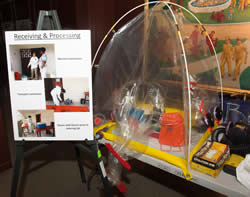
|
Caption:
Staff from the Naval Medical Research Center, Silver Spring, Maryland, set up this demonstration mobile laboratory using the same sort of equipment used during Operation United Assistance, a coordinated effort by the U.S. military to respond to the 2014 Ebola outbreak in West Africa. The demonstration mobile lab was featured during the National Museum of Health and Medicine's Medical Museum Science Café at NMHM in Silver Spring, Maryland, on Tuesday, Oct. 27, 2015. (Disclosure: This image has been cropped to emphasize the subject.) (National Museum of Health and Medicine photo by Matthew Breitbart / Released) |
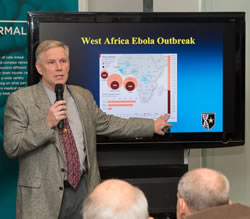
|
Caption:
Dr. Randal J. Schoepp, Immunodiagnostics and Biologics Department Chief, Diagnostic Systems Division, U.S. Army Medical Research Institute of Infectious Diseases (USAMRIID), Fort Detrick, Maryland, describes how USAMRIID supported Liberia Ebola diagnostic testing and Operation United Assistance, a coordinated effort by the U.S. military to respond to the 2014 Ebola outbreak in West Africa. Schoepp spoke at the National Museum of Health and Medicine's Medical Museum Science Café at NMHM in Silver Spring, Maryland, on Tuesday, Oct. 27, 2015. (Disclosure: This image has been cropped to emphasize the subject.) (National Museum of Health and Medicine photo by Matthew Breitbart / Released) |
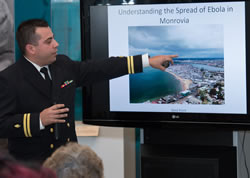
|
Caption:
LT Jose Garcia, Viral and Rickettsial Diseases Department, Infectious Disease Directorate, Naval Medical Research Center, Silver Spring, Maryland, describes how Navy Medicine supported Operation United Assistance, a coordinated effort by the U.S. military to respond to the 2014 Ebola outbreak in West Africa. Garcia spoke at the National Museum of Health and Medicine's Medical Museum Science Café at NMHM in Silver Spring, Maryland, on Tuesday, Oct. 27, 2015. (Disclosure: This image has been cropped to emphasize the subject.) (National Museum of Health and Medicine photo by Matthew Breitbart / Released) |
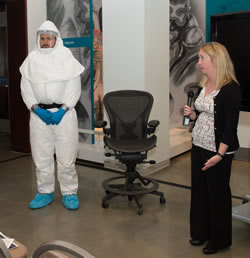
|
Caption:
Mr. Jon Horton (left) of the U.S. Army Medical Research Institute of Infectious Diseases (USAMRIID) demonstrates the proper outfitting of a medical worker using the kind of personal protective equipment used to respond to the 2014 Ebola outbreak in West Africa. Mrs. Kristie Yeakle (right), also from USAMRIID, describes the equipment Horton is wearing during the demonstration. Horton and Yeakle spoke at the National Museum of Health and Medicine's Medical Museum Science Café at NMHM in Silver Spring, Maryland, on Tuesday, Oct. 27, 2015. (Disclosure: This image has been cropped to emphasize the subject.) (National Museum of Health and Medicine photo by Matthew Breitbart / Released) |
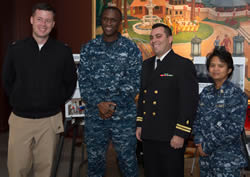
|
Caption:
Staff members from the Naval Medical Research Center, Silver Spring, Maryland, pose for a photograph near a display of mobile lab equipment similar to what was used in West Africa to combat the Ebola outbreak there in 2014. Seen in the photograph are: CDR Matthew Doan (left), deputy director, Biological Defense Research Directorate; Hospital Corpsman 1st Class (FMF) Yusupha Kah (second from left); LT Jose Garcia (third from left) Viral and Rickettsial Diseases Department, Infectious Disease Directorate; and Chief Hospital Corpsman Vilma Bauer, Biological Defense Research Directorate (right). (Disclosure: This image has been cropped to emphasize the subject.) (National Museum of Health and Medicine photo by Matthew Breitbart / Released) |
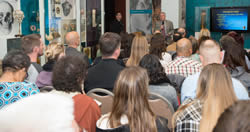
|
Caption:
Dr. Randal J. Schoepp, Immunodiagnostics and Biologics Department Chief, Diagnostic Systems Division, U.S. Army Medical Research Institute of Infectious Diseases (USAMRIID), Fort Detrick, Maryland, (standing, center) reviews the military medical response to the 2014 Ebola outbreak in West Africa. Schoepp spoke at the National Museum of Health and Medicine's Medical Museum Science Café at NMHM in Silver Spring, Maryland, on Tuesday, Oct. 27, 2015. (Disclosure: This image has been cropped to emphasize the subject.) (National Museum of Health and Medicine photo by Matthew Breitbart / Released) |



